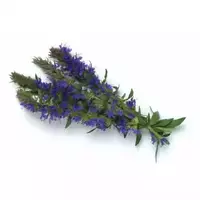Hyssop

Issop is a species of shrubs that grow in the countries of Africa and Eurasia, in Russia this plant can be found in Dagestan. The homeland of the issop is presumably Central Asia and the Mediterranean. The useful properties of issop are highly appreciated in medicine, this shrub is one of the most ancient medicinal plants used in ancient Greece. As a rule, for medical purposes, the upper part of the plant is used - leaves and stems. In terms of its therapeutic properties, issop is often compared with such a famous plant as sage.
In culinary affairs, dried leaves of the top (third part) of the plant are mainly quite widely used, and only salads made of cucumbers and tomatoes are often seasoned with fresh hyssop greens. This aromatic herb greatly improves the taste of pea and bean dishes, it is often added to vegetable soups, sausages, fried meat, and is also used in salting cucumbers, tomatoes or olives. Interestingly, in the East, hyssop is often added to fruit drinks.
Issop goes well with dill, parsley, fennel, celery, majorana, mint and basil. However, due to the sharp smell, it is advised to add the plant to dishes in small quantities. Both fresh and dried young shoots of issop with flowers and leaflets are used in cooking - they are distinguished by a ginger-sage aroma and a bitter pleasant taste.
When making the most tender fried veal, the added issop gives the finished dish a spicy, tart taste. In addition, it can be used in the preparation of fish dishes, fried pork, zraz from beef, stew, soup from beans, marinades and potatoes. Crushed issop is even added to cheese - it gives the product a savoury taste and a pleasant aroma. As for the essential oil of issop, as well as dry grass, these products are widely used to fragrance perfumes and drinks (usually liqueurs).
You can make fragrant tea from hyssop, which is inherent in healing properties - it is considered an effective natural remedy in the fight against cough and cold. By the way, for the treatment of hyssop can be used both independently and together with other medicinal herbs.
Different peoples have long used issop in folk medicine. It is noteworthy that even in Avicenna's treatise it is prescribed that issop is inherent in an antiseptic, anti-inflammatory, wound healing, analgesic, antitussive and exciting effect. It helps with heart disease (angina), neurosis, as well as diseases caused by GI problems. In addition, hyssop is often used to treat inflammatory processes of the oral cavity and pharynx.
Issopa 21 kCal
Energy value of issop (Ratio of proteins, fats, carbohydrates - ju):
Proteins: 3.9 g (~ 16 kCal)
Fats: 0.6 g (~ 5 kCal)
Carbohydrates: 0.2 g (~ 1 kCal)
Energy ratio (b | y): 74% | 26% | 4%
 Español
Español Français
Français Português
Português Русский
Русский 简体中文
简体中文 繁體中文
繁體中文 日本語
日本語 한국어
한국어 العربية
العربية Türkçe
Türkçe Қазақ
Қазақ Deutsch
Deutsch Italiano
Italiano Українська
Українська
